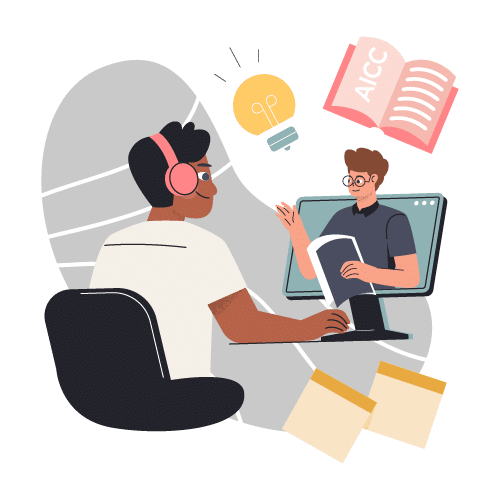Everything you needed to know, you learned in kindergarten—right?
While learners might yearn for the days of colorful circle carpets and a midday snack, adult learners don’t actually benefit much from the pedagogy of their youth. As learners age and gain more experience, they also take on defining characteristics that affect how they process and recall information. Understanding the unique learning characteristics of adults helps you create programs that tap into their motivation and reward them for their effort.
(Although, we always support the idea of a midday snack.)
Who Are Adult Learners?
Generally speaking, adult learners can be defined as any learner over the age of 25.
According to the National Center for Education Statistics, adult learners make up around half of all students enrolled in higher education. But adult learners don’t need to be on a college campus to expand their knowledge: thanks to training, conferences, online learning, and hands-on job training, adults can increase their skills on the job.
A definition of adult learners isn’t as important as understanding why and how they learn; figure that out, and you’ll be better prepared to create content with those characteristics in mind.
Adult learners can be every bit as enthusiastic as a class full of school kids—you just need to know how to access their motivation and capture their drive.
Characteristics of Adult Learners
Adult learners already have a lot on their plates. Balancing jobs, families, hobbies, health, and home, they’re much more seasoned at multitasking than younger learners, and are more selfish with their time.
Training for adults that acknowledges that their time is precious and that they already have a wealth of knowledge and experience under their belts will be more likely to stick, and be more relevant and impactful. Keep these characteristics of adult learners in mind before you start to build your training:
1. They’re Autonomous
Kids are used to being led in just about every aspect of their learning, but (hopefully) by adulthood, learning becomes more autonomous. Adults value the ability to pick and choose what’s important to them, which is why they sometimes feel less-than-engaged with heavily prescriptive and forced learning events. Allow choice on how, when, and what they learn, and adult learners will thank you.
2. They’re Purposeful and Motivated
Adult learners have the distinct advantage of understanding their own motivation. A child doesn’t always understand why he or she has to learn algebra or rattle off the countries of South America, but adult learners have more context. When they know the why behind their learning experiences, they’re more driven and motivated to achieve. Adult learners are also more likely to seek out learning experiences based on their individual needs. If they acknowledge that training will help solve an immediate issue, they probably won’t wait around until someone tells them how to fix it—they’ll find the solution and training themselves.
3. They Have More Experience
An adult learner isn’t flying blind: they’re constantly using their life experiences to color and give context to their opportunities. Using experience as a foundational aspect of creating an eLearning program means you’re not always starting from scratch. You can use tools like simulations, role playing, and even testing out of certain topics as a way to respect your learners’ past experiences and recognize them as individuals.
4. They’re Goal – and Results-Oriented
“Because I said so” is never going to fly with adult learners. They want to know why they’re engaging with training and then, they want to see the results of their time and effort. Sometimes called the “What’s in it for me” principle, adult learners are much more judicious with their time than younger learners. If they don’t immediately see the benefit or a way to measure their progress and proficiency, they’re less likely to engage in a meaningful way.
5. They Appreciate Community
While the idea of gathering around the watercooler seems like a thing of the past, adult learners still crave community. Autonomy in choosing relevant learning experiences is appreciated, but walking that learning path alone can feel isolating. Building in opportunities to connect with other learners offers them the chance to share, discuss, and even practice new skills in a safe space. It all adds to better learning experiences—together and apart.
6. They’re Responsible for Their Own Mastery
No report cards here: You shouldn’t have to push and prod adult learners to master a new skill or topic. That’s because they’re experienced enough to understand that their level of input is directly related to their output and there’s nowhere to pass the buck if they fall short.
Use that sense of responsibility to create learning experiences where learners can demonstrate their mastery and receive positive feedback, even if it’s just from themselves.
7. They’re Change Resistant
Let’s face it: Adults are, in general, fairly resistant to new things. Once they’ve locked into their preferred way of doing something, introducing a new skill, policy, or protocol can be a hard sell. Still, there are ways to get around that resistance, including how you introduce a new training program. By highlighting how it will benefit them (a new skill makes work faster or results in more sales, for instance), the change will be welcomed rather than worrisome.
8. They Love to Solve Problems
Adult learners are problem solvers; they see a need or an area where they’re lacking, and want to improve. When faced with a roadblock, most adult learners are willing to do what it takes to overcome it. Training can be contextualized as a way to solve problems they face every day, further increasing buy-in and motivation. What’s more, adult learners want to understand problems on an organizational level so they can become part of the solution.
Creating Adult Learning Experiences
Once you’ve gotten to know adult learners a little better, you can begin creating training programs that are better tailored to why and how they learn. You might find that past failed attempts at training were really just misaligned to your audience. By reframing your content and giving plenty of context, you break past the barriers resistant adult learners put between themselves and their training experiences.
Sure, they learned a lot in kindergarten, but adult learners have had decades of learning experiences since then. Capitalizing on their experiences and building upon what your learners already know will add relevance and increase their motivation to learn.





